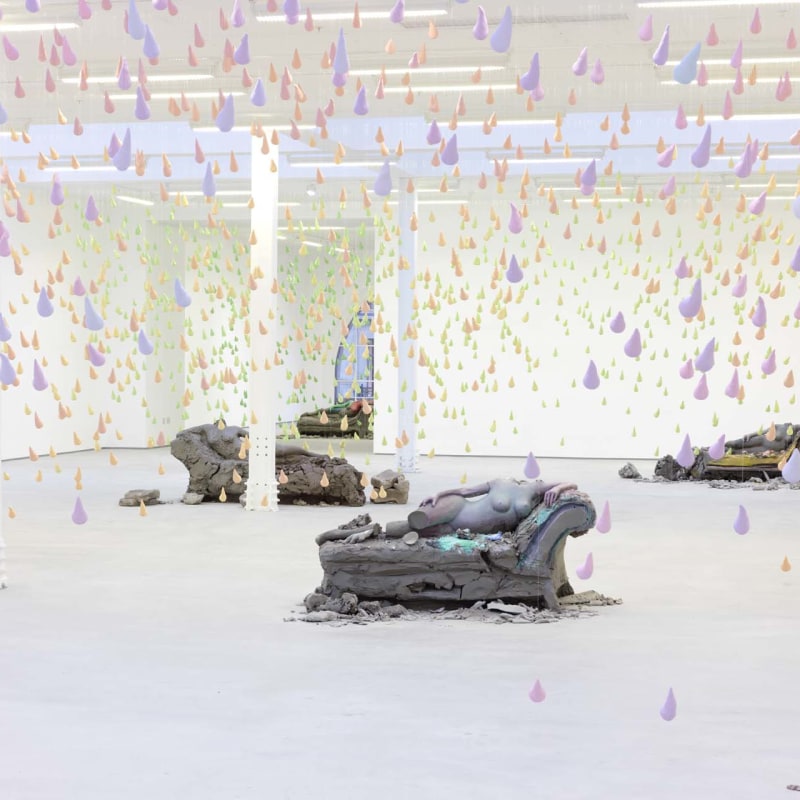Urs Fischer’s new exhibition at Sadie Coles HQ centres on an installation of 3,000 plaster raindrops suspended throughout the gallery. Titled Melodrama, the raindrops encompass a spectrum of shades from green to lilac, massing together into a gently psychedelic storm cloud which weaves in a swirling movement through the space. Yet their forms are incongruously physical – each droplet is a bulbous pendant cast from a hand-modelled prototype, and hangs from the ceiling by lengths of near-invisible monofilament. The installation’s romantic overtones collide with a bluntly cartoonish quality, bordering on the slapstick, that resonates with the double-edged register of much of Fischer’s art.
Dispersed and amorphous, the installation swells through the length and breadth of the gallery, at the same time as it frenetically splits the space and circumscribes our movement within it. Fischer skews our sense of scale – viewers become Lilliputians within the sea of oversize drops – while simultaneously he effaces basic distinctions between outside and inside, architecture and landscape. We are required to pass through narrow channels, to the extent that it is perhaps impossible to perceive the work in its totality. The raindrops therefore dramatise – and radically extend – Charles Baudelaire’s idea that sculpture has “a hundred different points of view”, presenting a limitless number of facets and avenues. Fischer has previously played with ideas of finite or infinite points of view, above all in his series of mirrored boxes (one group of which was exhibited in 2010 at Sadie Coles) bearing discrete views of miscellaneous objects on each of their five faces. Melodrama also speaks of a tension between naturalism and surreal artifice that runs through Fischer’s work; its torqued shape evokes a windswept shower at the same time as being preternaturally static and calm, as if permanently arrested in an airborne swerve. The drops appear both comically globular and disarmingly weightless. Each drop ranges in appearance from a smooth teardrop to a pearlike clod (it is perhaps no coincidence that food – apples, pears, croissants – has appeared in absurdist scenarios throughout Fischer’s oeuvre).
The heaviness and irregularity of the objects compound their lurking air of oddness. The arrayed drops begin to resemble other free-floating bodies – tangible or virtual, magical or mundane – from a swarm of gloopy commas to squirts of icing. They are emblematic of a strain of fairytale-style surrealism that pervades Fischer’s work, manifested variously by his wryly anthropomorphic furniture (including a lilac-hued grand piano collapsing droopingly like one of Dalí’s melting watches) or by the wax effigies which slowly implode into formlessness as wicks burn within them. Myriads of coloured droplets have featured explicitly in Fischer’s earlier work. This is the third in a series of expansive installations of raindrops including Vintage Violence (2004–05) and Horses Dream of Horses (2004), which respectively present blood-red and turquoise explosions of droplets. In more recent works such Secret (2012–13), globular raindrops are printed in dense clusters across the large, sultry headshots of 1950s Hollywood idols.
Mirroring the hand-sculpted forms of the raindrops are new sculptures in clay. Much of Fischer’s recent work has employed this medium: in 2011, he began an on-going public art project in which members of the public are invited to make objects out of freely supplied clay. Here, a single figurative sculpture is repeated in clay throughout the gallery, teasing out a dualism between originals and copies that has underpinned much of his art. In 2011, in the latest (and perhaps most literal) in a string of references to the working space of the artist’s studio, he collaborated with German artist Georg Herold in modelling clay figures from nude models; the objects were then exhibited alongside the same nude figures. Here, the sculptures appear metamorphic and unstable, redolent not only of tragic Pompeian casts but also the melting figures of Medardo Rosso (themselves often only preserved in the mediated form of photographs). Collectively, these sculptures describe an earthbound world of disorderly, golem-like forms in contrast with the symphony of suspended shapes above. The floor-based works and the raindrops constitute a ‘heaven and earth’ tableau that is at once pointedly familiar and otherworldly.
Urs Fischer (b. Switzerland, 1973) traverses the fields of painting, sculpture and installation, as well as photography and drawing, in a multifaceted body of work that eludes formal or generic categorisation, coaxing comparisons with the multifarious practices of Martin Kippenberger, Franz West, Fischli & Weiss, and others. His work simultaneously echoes the shifting moods of Dada, Pop Art and conceptualism; and he deploys a dizzying range of materials from food to mirrors to dirt. Urs Fischer lives in New York. Recent major exhibitions include those at MOCA, Los Angeles, 2013; Madame Fisscher, Palazzo Grassi, Venice, Italy, 2012; and Skinny Sunrise, Kunsthalle Wien, Vienna, 2012. He has had solo shows throughout Europe and the USA, including Oscar the Grouch, The Brant Foundation, Greenwich (CT) (2010) and Marguerite de Ponty, New Museum, New York (2009). In 2004, Not My House Not My Fire took place at Espace 315, Centre Pompidou, Paris, and the retrospective Kir Royal was held at Kunsthaus Zürich, Switzerland. Urs Fischer’s work has been included in numerous group exhibitions including the Venice Biennale in 2003, 2007, and 2011.
For further information please contact the gallery at +44 (0)20 7493 8611 or press@sadiecoles.com
